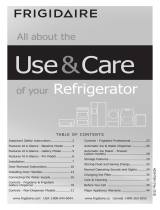
15
Ice Service
If your freezer has an automatic icemaker,
it will provide a sufficient supply of ice
for normal use. During the initial startup
of your freezer, however, no ice will be
produced during the first 24 hours of
operation. Automatic ice makers are also
optional accessories that may be installed
in some models at any time. Call your local
dealer for information.
Turning Your Ice Maker On
After the plumbing connections have been
completed, the water supply valve must
be opened. Place the ice container under
the ice maker, pushing it as far back as
possible. Lower the wire signal arm to its
“down” or ON position. New plumbing
connections may cause the first production
of ice cubes to be discolored or have an
odd flavor. These first cubes should be
discarded until the cubes produced are free
of discoloration and taste.
Turning Your Ice Maker Off
To stop the ice maker, lift the wire signal
arm until it clicks and locks in the “up” or
OFF position. The ice maker also turns
off automatically when the ice container is
full. If your model has an adjustable freezer
shelf, place the shelf in the lower position,
so that the wire signal arm will hit the ice
when the container is full.
Ice Maker Tips
• If the ice maker will be turned off for
a long period of time, turn the water
supply valve to the closed position.
• Ice cubes stored too long may
develop an odd flavor. Empty the
ice container and ensure that the
wire signal arm is in its “down” or
ON position. The ice maker will then
produce more ice.
• Occasionally shake the ice container
to keep ice separated.
• Keep the wire signal arm in its “up”
or OFF position until the freezer is
connected to the water supply or
whenever the water supply is turned off.
• The following sounds are normal
when the ice maker is operating:
• Motor running
• Ice loosening from tray
• Ice dropping into ice container
• Running water
• Water valve opening or closing
Wire
Ice
Container
Leveling Bracket
IMPORTANT
Your ice maker is shipped with the wire
signal arm in the ON position. To ensure
proper function of your ice maker, hook
up water supply immediately or turn ice
maker OFF by lifting the wire signal arm
until it clicks and locks in the UP position.
Check the leveling bracket on the ice
maker to ensure the ice maker is level.
If the gap between the freezer wall and
the ice maker is the same at top and
bottom, then ice maker is level. If the ice
maker is not level, loosen the screw and
slide the bracket to the correct position
to make it level. Retighten the screw.
You will need a ¼” socket wrench for
this task.
CAUTION
• DO NOT place the ice container
in dishwasher.
• Wash the ice container in warm
water with mild detergent. Rinse
well and dry.
• Stop the ice maker when cleaning
the freezer and during vacations.




















